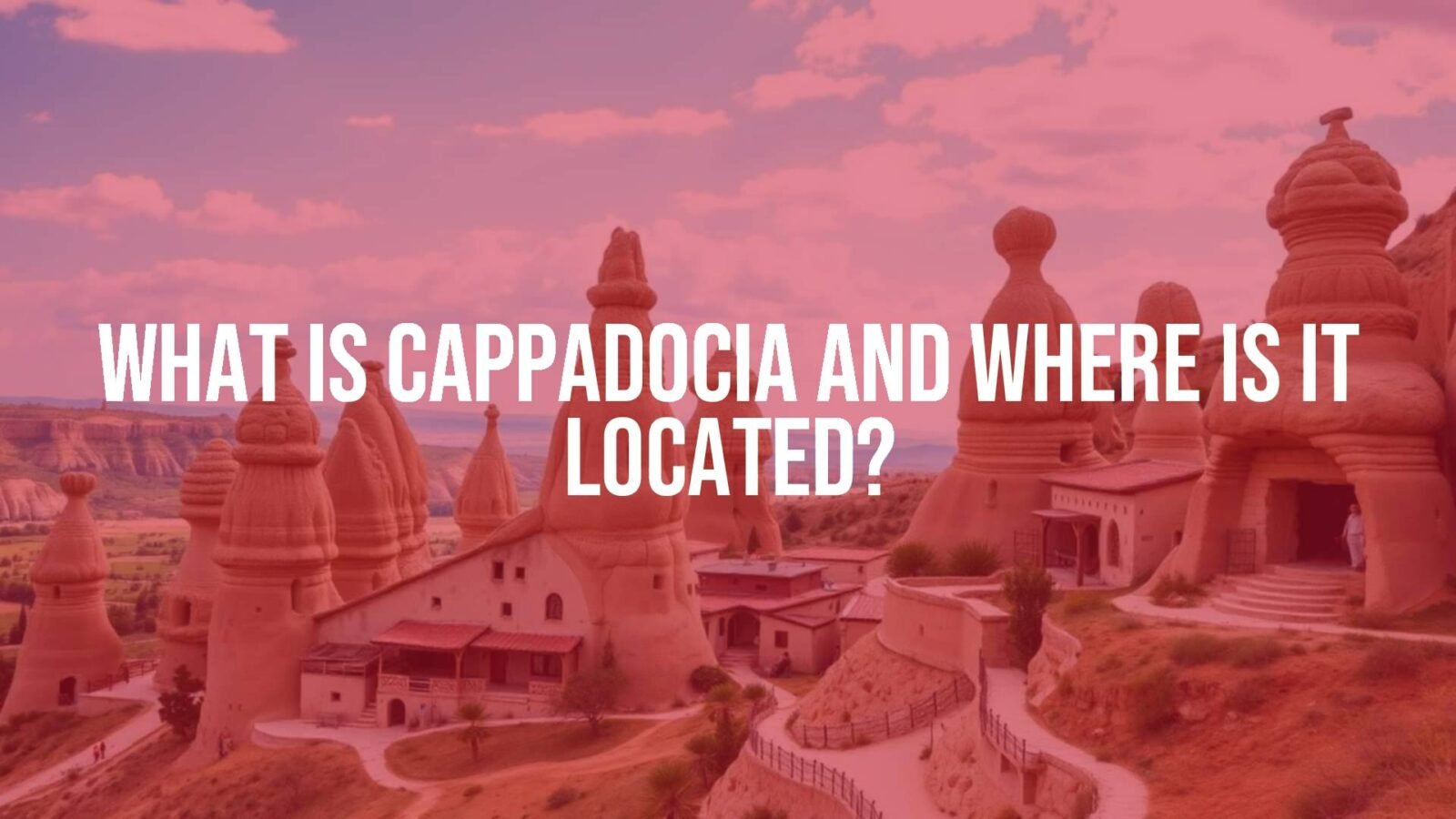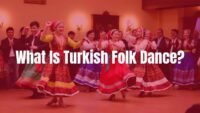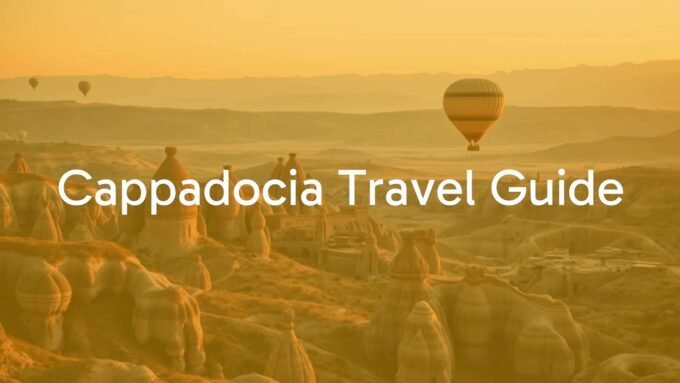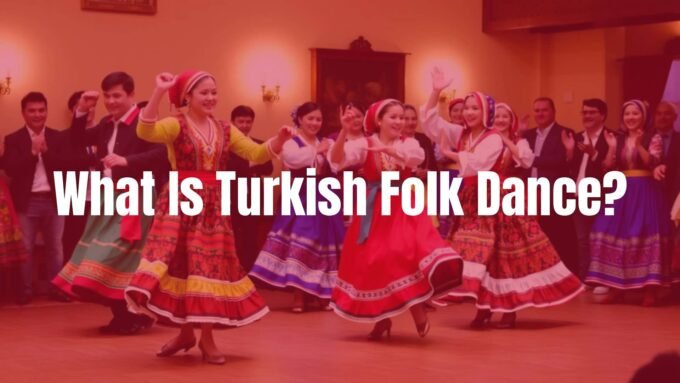Cappadocia is a region in central Turkey known for its “fairy chimney” rock formations and ancient cave homes. Set in central Anatolia, it offers strange, beautiful scenery, fun outdoor activities, and a deep history. It’s a whole region rather than one town, and its appeal is spread across several different areas.
The Turkish name is “Kapadokya,” said with a strong “k,” showing its long history. It can look far away on a map, a few hundred kilometers from Turkey’s border with Syria, but the main tourist towns are safe and welcoming. Many travelers place Cappadocia high on their wish list, coming to see its dreamy and otherworldly views.

How Did Cappadocia Form? A Brief Geological and Cultural History
The landscape did not appear overnight. More than a million years ago, volcanoes such as Mount Erciyes, Mount Hasan, and Mount Gullu covered the area with soft ash. Over many ages, wind and water slowly carved that ash. Harder basalt caps stayed on top, shielding the softer rock below and leaving the tall cones we call fairy chimneys, which created the shapes we see today.
The story is also about people. The Hittites lived here in the second millennium BCE, followed by Assyrians and others. The soft rock made natural shelters that early residents enlarged into homes, churches, and underground cities. As Christianity spread across Asia Minor, Cappadocia became an important refuge for people under threat. Early Christians carved cave churches with painted frescoes and built underground cities like Kaymaklı and Derinkuyu to hide during invasions. This mix of dramatic nature and human skill makes Cappadocia special.
Major Towns and Regions in Cappadocia
“Cappadocia” covers a wide area that includes cities like Nevşehir, Kırşehir, Niğde, Avanos, Aksaray, and Kayseri. For visitors, the main tourist area sits in a triangle formed by Göreme, Ürgüp, and Avanos. Uçhisar and Ortahisar are also part of this core area, each with its own style and sights.
- Göreme: Often the main base for travelers and the spot you see in many balloon photos. It has the most hotels, restaurants, and tour offices, and the center is easy to walk. Many hotels are carved into fairy chimneys, offering true cave stays.
- Uçhisar: About 10 minutes from Göreme by car, centered around Uçhisar Castle, the highest point in Cappadocia. It leans more upscale, with wide views. Balloons at sunrise are a bit farther away than in Göreme.
- Ürgüp: Slightly off the busiest routes, with a more local feel. It still has plenty to do and some standout cave hotels, such as Yunak Evleri Cappadocia.
- Avanos: On the Kızılırmak (Red River), famous for pottery since Hittite times. You can visit workshops and try throwing clay yourself.
- Ortahisar: A quieter town with an impressive rock-cut castle and a calm vibe.
Each town offers a different take on Cappadocia, so you can pick the base that fits your plans.
When Is the Best Time to Visit Cappadocia?
Cappadocia is worth visiting all year. Each season offers a different look and feel. Many people like spring and autumn best.
The most pleasant window is April to October. April, May, September, and October stand out for warm, comfortable weather and fewer people than midsummer. These months are great for hiking and sightseeing and give you good odds for balloon flights.
Seasonal Weather Patterns and Ballooning Conditions
Knowing the weather by season helps you plan, especially if a balloon ride is a must:
- Spring (April-May) and Autumn (September-November): Often the best time. Warm days suit hiking and horseback rides. Mornings can feel cold during sunrise, so pack layers. More stable weather often means more balloon flights.
- Summer (June-August): Hot and busy, with highs around 27-32°C (80-90°F). Balloons fly often, but heat can make daytime visits harder. Hotel rates peak. A pool helps a lot.
- Winter (December-March): Snow can cover the chimneys, making a beautiful scene. It’s low season with fewer visitors and lower hotel prices. Balloons still fly, but more flights get canceled due to wind or poor weather. It can be very cold, with temps below freezing. Wear warm layers. Some small places close for the season.

Balloon flights run only if the weather is safe. If winds are too strong, they cancel. Companies usually decide by 2:00 PM the day before, but plans can still change in the morning. Book 3-4 mornings in Cappadocia if you want to raise your chances of flying.
Cappadocia Festivals and Special Events
Dates shift each year, but you can catch cultural and seasonal events, such as harvest fairs, music and dance shows, and art exhibits. Check local tourism sites close to your trip. Public holidays in Turkey and school breaks in Europe can affect crowds and prices, so check those as well.
How Many Days Are Recommended for a Cappadocia Trip?
Plan for at least three to four days to get a good feel for the area. You can rush through the main sites in less time, but a slower pace works better. Three nights with two full days and three sunrise chances is a solid plan. For a wider and calmer visit-especially with weather affecting ballooning-four to five days (or more) works best.
Early mornings for balloons can be tiring if you try to do too much. A longer stay lets you spread things out so you don’t feel rushed and gives room to rebook balloons if needed. Extra time also lets you find quieter spots and enjoy local life. With five or more days, split your stay between Göreme and Uçhisar for two different viewpoints.
Suggested Itineraries: Short Stays to Week-Long Visits
- 2-Day Whirlwind (2 nights, 2 mornings): Very tight and weather-dependent. Focus on a balloon ride (if it runs), Göreme Open Air Museum, Uçhisar Castle, and a major valley like Love or Rose Valley. Consider guided tours to save time.
- 3-Day Essentials (3 nights, 3 mornings): A smoother plan with time for a balloon ride or at least a few mornings to watch.
- Day 1: Arrive and check in to your cave hotel. Stroll Göreme. Catch sunset at a viewpoint.
- Day 2: Sunrise balloon ride or viewing. Visit Göreme Open Air Museum. Hike Rose and Red Valleys.
- Day 3: Visit an underground city (Kaymaklı or Derinkuyu). See Uçhisar Castle and Pigeon Valley. Stop by Pasabag (Monks Valley) and Devrent Valley.
- 4-5 Day Immersion (4-5 nights, 4-5 mornings): Ideal for first-timers who want a balanced schedule.
- Start with the 3-day plan, then add:
- Extra Day(s): Try horseback riding, an ATV tour, or a pottery class in Avanos. Visit Zelve Open Air Museum or Çavuşin village. Take a longer hike in Ihlara Valley, or relax by your hotel’s cave pool. Extra days also help if balloons get canceled.
- Week-Long Stay (7+ nights): For those who want to explore in depth. Split time between Göreme and Uçhisar, hike multiple trails, see more underground cities, and enjoy local food without rushing. Great for photographers, history fans, and hikers.
Getting to Cappadocia: Transport Options by Air, Road, and Rail
Reaching Cappadocia is fairly easy. Most international visitors fly, usually with a connection in Istanbul.
Which Airports Serve Cappadocia?
Two nearby airports serve the region:
- Kayseri Erkilet Airport (ASR): The larger option, about an hour by car from Göreme. Turkish Airlines and Pegasus fly here often from major Turkish cities, especially Istanbul. Fares from Istanbul can be as low as £40 one way.
- Nevşehir Kapadokya Airport (NAV): Closer to Göreme, around 40 minutes by car. Fewer flights than Kayseri, but quicker transfers.
Most flights connect via Istanbul Airport (IST) or Sabiha Gökçen (SAW). Check both airports and compare prices and times.
Are There Direct Buses or Trains from Major Cities?
Flying is fastest, but buses and some train options exist if you prefer land travel or have a smaller budget.
- Bus: Turkey’s intercity buses are widespread and reliable. There are direct routes to Nevşehir or Göreme from cities like Istanbul, Ankara, and Antalya. Trips can be long (10-12 hours from Istanbul) but cost less than flights. Overnight buses are common and drop you near the center in Göreme.
- Train: There’s no direct high-speed train into the main tourist area. You can take a train to Kayseri, then continue by bus or private transfer to your hotel. This is less common than flying due to the extra step and time needed.
Tips for Transfers and Private Car Rentals
After landing in Kayseri or Nevşehir, choose one of these options to reach your hotel:
- Hotel Transfers: Many hotels can arrange pickups that match your flight time. A driver meets you on arrival, making the trip easy and smooth.
- Shuttle Services: Shared shuttles cost less than private cars. Book online or through your hotel. They may wait for other passengers, so the ride can take a bit longer.
- Taxis: Available at both airports. Convenient but usually pricier than shuttles. Agree on the fare before you start.
- Car Rentals: Great if you want to explore on your own schedule. Pick up at the airport. Roads are wide and well kept, and driving is straightforward. This works well for families or groups and for reaching spread-out sights.
For late-night arrivals or long travel days, pre-book a private transfer or hotel shuttle to avoid stress. Groups of four or more may find a private shuttle good value.
How to Get Around Cappadocia: Local Transportation Explained
Once you arrive, getting around the area takes a bit of planning. Town centers are walkable, but many valleys and historic sites are spread out. Your choice depends on budget, how flexible you want to be, and whether you prefer to explore alone or with a guide.
Car Rentals and Driving in Cappadocia
Renting a car is one of the best ways to explore. You can move at your own pace, spend more time where you like, and visit different viewpoints for sunrise and sunset. Rentals are available at the airports and in towns like Göreme. Roads are generally quiet and well maintained, and GPS works fine. A car makes it easy to reach trailheads, remote valleys, and quieter spots. For families or groups, it can be cheaper than multiple tours or taxis.
Public Transport, Shuttles, and Taxis
If you’d rather not drive, you still have options:
- Public Buses (Dolmuş): Small buses link towns like Göreme, Uçhisar, Ürgüp, and Avanos. They cost the least but run less often and usually stop early in the evening. Good for short hops but not for every viewpoint.
- Hotel Shuttles: Some hotels run shuttles to the airport or popular spots. Ask your hotel what they offer.
- Taxis: Easy to find in main towns. You can hire one for single rides or arrange a set price for several stops or hours. If you don’t see one, your hotel can call a taxi for you.
- ATV and Horseback Riding: Fun ways to reach trails and viewpoints that cars can’t. These tours give you a fresh angle on the landscape.
Guided Tours vs. Independent Exploration
Choose what fits your style:
- Guided Tours: The popular “Red Tour” covers northern sights like Göreme Open Air Museum, Pasabag, and Avanos. The “Green Tour” covers the south, such as Derinkuyu Underground City and Ihlara Valley. Tours pack a lot into one day, include transport, and come with a guide who shares history and culture. You can book through your hotel or online.
- Independent Exploration: With a rental car, you can plan your own route, linger at favorite places, and find quieter corners. Without a car, you can still mix taxis, walking, and the odd local bus if you like to figure things out on your own.
Hiring a private guide gives you added insight into the geology and history. They can adjust the plan to match your interests.
Where to Stay in Cappadocia: Hotels, Cave Suites, and Villages
Cappadocia’s hotels are famous for cave rooms built into the rock. You can sleep in carved stone suites with unusual rock shapes right outside your door. Prices range from budget to luxury.
Popular Towns for Accommodation: Göreme, Ürgüp, Uçhisar, Avanos
Your choice of town will shape your trip:
- Göreme: The busiest base for first-time visitors. You’ll find the most hotels, places to eat, and tour offices. Balloons often drift closest to the hotels here at sunrise. The center is lively and easy to walk, with many budget options.
- Uçhisar: A 10-minute drive from Göreme, built around its castle. Hotels tend to be more luxurious, with wide, sweeping views. Balloons are usually farther away at dawn.
- Ürgüp: Quieter than Göreme and Uçhisar, with a more local feel. Still has plenty of cave stays and activities.
- Avanos: The pottery town to the north. Fewer cave hotels but a charming base, especially if you like crafts and a calmer setting.
If you have five or more days, splitting time between Göreme and Uçhisar is a great way to enjoy both atmospheres.
Types of Hotels: Cave Hotels, Boutique Inns, Family Options
Most places are cave-style, but there’s a range within that theme:
- Authentic Cave Hotels: Carved into the rock, naturally cool in summer and cozy in winter. Choices range from small family places to high-end suites.
- Boutique Inns: Mix classic cave design with modern comfort, often with terraces and valley views. Many offer personal service.
- Family Options: Many hotels welcome families and offer larger rooms. If traveling with kids, check age rules for activities like balloon rides.

Top-Rated and Unique Stays
Standout options include:
- Sultan Cave Suites (Göreme): Famous for its sunrise terrace and views of balloons. A luxury cave stay, around £250 per night.
- Koza Cave Hotel (Göreme): Small, family-run boutique with 10 cave suites and the highest rooftop in Göreme. Warm, friendly hosts.
- Aza Cave Cappadocia Adult Hotel (Göreme): Luxury boutique, adults only, with a new pool ringed by chimneys. Sister hotel to Sultan Cave Suites; rooms from about €180.
- Local Cave House Hotel (Göreme): Not the most fancy, but the pool sits under huge fairy chimneys for a surreal scene. Around £287 per night.
- Museum Hotel (Uçhisar): Turkey’s only Relais & Châteaux, with big views and a Roman-style heated outdoor pool. Feels like a living museum.
- Argos in Cappadocia (Uçhisar): A restored monastery with 50+ rooms, some with indoor cave pools, plus an upscale restaurant and sweeping views.
- Imperial Cave Suites (Göreme): Set among cone-shaped rocks with 24 rooms, an indoor pool, and an underground hammam. A nice budget-friendly pick.
- Kelebek Special Cave Hotel (Göreme): Cliffside setting with wide views and charming cave rooms formed from chimneys.
- Rox Cappadocia (Uçhisar): A former Greek house turned luxury stay with only eight rooms and great terraces over Göreme and Güvercinlik Valley.
- Divan Cave Suites (High End): Rooftop terrace with a prime view of Göreme and balloons.
- Grand Elite Cave Suites (Midrange): Well-rated, with a good breakfast and pool.
Pick based on the vibe you want, how close you want to be to certain sights, and the view you want in the morning. Many places sit close to major viewpoints, and walking the hilly streets is part of the fun.
Where to Eat in Cappadocia: Cuisine and Recommended Restaurants
Food is a big part of any trip, and Cappadocia has a lot to try. You’ll find classic Turkish dishes and local recipes passed down for centuries, plus modern takes on old favorites.
Typical Dishes: Testi Kebab, Gözleme, and Regional Specialties
Try these local staples:
- Testi Kebab (Pottery Kebab): A rich stew of meat or vegetables sealed in a clay pot with spices, onions, garlic, and potatoes. The pot is cracked open at the table, releasing a wave of steam and aroma. It cooks a long time, so order ahead when you book a table.
- Gözleme: Thin flatbread filled with cheese, spinach, potato, or minced meat, cooked on a convex griddle. Great for a snack or light meal, often made fresh at stalls.
- Meze Platter: A spread of small plates like hummus, eggplant salad, yogurt dips, stuffed grape leaves, and seasonal veggies. Perfect for sharing.
- Dondurma (Turkish Ice Cream): Dense and stretchy thanks to salep and mastic. Vendors often put on a little show before handing over your cone.
- Börek: A pastry made with thin dough, filled with cheese, spinach, or meat. It can be crisp or soft depending on the style.

Notable Restaurants and Cafés by Town
Great places to eat include:
- In Göreme:
- Seten Restaurant: At Sultan Cave Hotel, with traditional dishes, famous mezes, and Turkish ravioli. Enjoy a drink on the rooftop before dinner.
- Dibek Restaurant: Set in a 475-year-old building with floor seating. Known for pottery kebab (order ahead).
- Topdeck Cave Restaurant: Intimate cave setting with tasty Turkish food. Book a table.
- Cappadocian Cuisine Restaurant: Classic Turkish dishes with a well-loved künefe dessert.
- Kebabzade Restaurant: Kebabs, mixed grills, and pottery dishes at fair prices.
- The Grape: Wide menu with salads, seafood, meats, and homemade desserts. Lovely evening views of lit chimneys.
- Namaste India: A good option if you want Indian food.
- Firin Express: Popular for Turkish pizza and pottery kebab.
- Fat Boys: Known for tasty döner rolls.
- Pumpkin Goreme Restaurant: Restaurant and art gallery in one.
- Kaira Rooftop & Bar: At Artemis Cave & Suites, serving Turkish classics with sunset views and music.
- In Uçhisar:
- Reserved Cappadocia: Stylish Turkish spot with a full bar, terrace, and fresh, carefully plated dishes.
- Lila Restaurant at Museum Hotel: A beautiful setting with big views for a special night out.
- Peri Evi Cafe: Tiny, family-run café facing Uçhisar Castle, perfect for a cool drink and a view.
- In Avanos Valley:
- Home dining experiences set up by local operators (like Turkish Heritage Travel) offer homemade Turkish meals, often vegetarian.
Local Markets, Turkish Coffee, and Dessert Experiences
Beyond restaurants, try these:
- Local Markets: Visit markets in Avanos or Ürgüp for fresh produce, cheeses, spices, and sweets.
- Turkish Coffee and Tea: Turkish coffee is strong and rich, brewed in a special way. Tea (çay) is everywhere and often offered while you shop.
- Dessert Cafes: Look for baklava, künefe, and other treats. King’s Coffee Shop is known for tres leches cake and special tea blends.
Some places that look “touristy” can serve great food, while some “old-style” spots may cater mostly to visitors. Ask locals for tips, and check prices for drinks or special dishes at viewpoints to avoid surprises.
Top Things to Do in Cappadocia
Cappadocia offers many activities that mix striking scenery, history, and outdoor fun. From sunrise flights to tunnels below ground, it has something for everyone.
Hot Air Balloon Rides: Booking, Costs, and What to Expect
Probably the most famous activity here, a sunrise balloon ride is on many travel lists. Watching dozens or even hundreds of balloons rise as the sun lights up the valleys feels magical.
- Booking: Book well in advance, especially in busy months or if your time is short. Well-known companies include Kapadokya Balloons, Turkiye Balloons, Turquaz Balloons, and Royal Balloon. Your hotel can help, or you can book online.
- Costs: Prices change with season, demand, and company. April-October can be €250+; winter can drop to around €100. Most prices include hotel pickup, a light breakfast, a 45-60 minute flight, and a small celebration with a certificate after landing.
- What to Expect:
- Early Start: Pickup is before dawn.
- Weather Dependent: Safety comes first. If wind is too strong or conditions are poor, flights are canceled. Companies usually set a plan by 2:00 PM the day before and confirm in the morning. If canceled, you get a full refund. Schedule your flight for an early morning in your trip so you can try again if needed.
- The Experience: You’ll watch the balloon inflate, then lift off gently. Pilots often fly high and also skim low through valleys, passing near chimneys.
- Photography: Enjoy the ride; photos from a crowded basket can be tricky. Use other mornings to shoot balloons from the ground at viewpoints.
Major Valleys: Love Valley, Rose Valley, Red Valley, Pigeon Valley
These valleys are the core of Cappadocia’s scenery. You can reach many of them by car, but hiking, ATVs, or horses let you go deeper.
- Love Valley: Famous for tall, pillar-like chimneys. Great for sunrise balloon photos.
- Rose Valley & Red Valley: Often done together. Rock faces shine pink and red near sunset. The trails pass by churches and cave homes, with tea stops along the way.
- Pigeon Valley: Known for small holes carved for pigeons, once used for fertilizer. It links Göreme to Uçhisar and makes a scenic walk.
- Devrent Valley (Imagination Valley): Rocks shaped like animals-camels, snakes, seals, even a dragon. A fun pick for families.
Göreme Open Air Museum and Other Historical Sites
History lovers will enjoy the rock-cut churches and monasteries.
- Göreme Open Air Museum: A UNESCO site with many cave churches and monasteries from the 10th-12th centuries, covered in detailed frescoes. A guide helps you understand what you’re seeing. Go early to skip crowds.
- Zelve Open Air Museum: Near Pasabag and less busy. Once a large cave town and monastic site, it shows older styles of rock art and homes. Great for wandering through abandoned passages.
- Açık Saray Museum (Open Palace): Off the main trail and now free, spread over a wide area with cave houses, a church, and a cathedral. Lovely near sunset.
Underground Cities: Kaymaklı, Derinkuyu, Özkonak
Explore the underground networks built as hideouts in times of danger.
- Kaymaklı Underground City: One of the widest, with eight levels (five open). Built with churches, kitchens, and more. The route is easy to follow.
- Derinkuyu Underground City: The deepest and most popular, with narrow passages and many chambers.
- Özkonak Underground City: Smaller and quieter. Arrive early to miss bus groups, and bring a headlamp.
Uçhisar Castle and Panoramic Viewpoints
Head up high for sweeping views.
- Uçhisar Castle: A towering rock fortress and the highest point in the region. Climb for wide views and great photos. The rock holds many abandoned rooms and tunnels.
- Sunset Point (Göreme): A classic viewpoint over town for sunrise balloons or evening colors. There may be a small entry fee, and it can feel chilly, so bring a jacket.
Pasabag (Monks Valley) and Fairy Chimney Formations
See some of the region’s most striking chimneys.
- Pasabag (Monks Valley): Famous for “mushroom” chimneys with double or triple caps. Some homes were carved 10-15 meters up. Go early or late to avoid the crowds.
Sunrise and Sunset Viewing Spots
Sunrise and sunset are peak moments, balloons or not. Good places include:
- Hotel rooftops (Sultan Cave Suites, Koza Cave Hotel)
- Love Valley (sunrise balloons)
- Rose Valley (sunset colors)
- Sunset Point in Göreme
- Uçhisar Castle
Horseback Riding, Hiking, and Outdoor Activities
“Land of beautiful horses” fits the area well. Many ranches run rides at different times of day. Trails suit all levels of hikers, and ATV tours add a bit of speed to rough routes.
Pottery and Craft Workshops in Avanos
Head to Avanos to watch potters at work, learn about a craft that goes back to Hittite days, and try the wheel yourself. Smaller, family-run studios feel more personal.
Shopping for Local Handicrafts: Rugs, Pottery, Lanterns
Shop for Cappadocian pottery, fine Turkish rugs, mosaic lamps, and other handmade items. Look for reputable sellers if you want authentic pieces. Sultan Carpets and Galerie Ikman are famous; some popular spots charge a small fee for photos.
Travel Tips for Visiting Cappadocia
A bit of planning makes your trip smoother. Keep these points in mind.
Is Cappadocia Safe for Tourists?
Yes. Cappadocia is widely seen as very safe. It’s far from trouble areas, and visitors often say they feel completely safe here. Locals are kind and welcoming, and hospitality is a big part of daily life. As always, use normal care: stay aware of your surroundings and keep valuables secure.
What to Pack for Different Seasons
Turkey’s seasons vary a lot, so pack for the time of year you visit.
- Spring/Autumn (April-May, September-October): Weather changes through the day.
- Layers help: Sunrise can be cold (around 2°C/36°F in mid-September) even if days are warm. Bring sweaters, a light jacket, and long sleeves.
- Comfortable footwear: Wear sturdy walking shoes or hiking boots for valleys, museums, and smooth rock. Skip flip-flops and slick soles.
- Sun protection: Bring sunscreen, a hat, and sunglasses.
- Summer (June-August): Hot and dry.
- Light clothes: Breathable fabrics like cotton or linen.
- Swimwear: Handy if your hotel has a pool.
- Sweater/light jacket: Sunrise at altitude can still feel cool.
- Hydration: Carry plenty of water.
- Winter (December-March): Cold, with possible snow.
- Warm layers: Thermals, sweaters, and a warm coat.
- Winter gear: Hat, gloves, and scarf.
- Waterproof boots: Good grip helps on snow or ice.
Dress Code and Cultural Considerations
Cappadocia is relaxed about clothing. Wear what you’re comfortable in for walking and hiking. Dress modestly when visiting mosques: women should cover shoulders and knees and often the head. A scarf in your bag is useful.
Budgeting and Money Matters
- Currency: Turkish Lira (TL).
- Cash vs. card: Cards work at most hotels, larger restaurants, and some tour companies. Carry cash for small shops, markets, and simple cafés.
- ATMs: Easy to find in towns like Göreme. Withdraw cash at the airport or soon after you arrive.
- Tipping: In tourist areas, tipping is common. Around 5-10% or rounding up is fine.
- Hotel prices: Cheaper from December to February, highest June to August. April and May often have good rates.
Language, Connectivity, and Local Etiquette
- Language: Turkish is the main language. Many people in tourist jobs speak English. Simple Turkish phrases like “Merhaba” (hello), “Teşekkür ederim” (thank you), and “Lütfen” (please) are appreciated.
- Connectivity: Wi-Fi is common in hotels and many cafés. A local SIM helps with maps and calls.
- Local etiquette: People are friendly. A smile and polite manner go a long way. Bargaining is normal in markets and souvenir shops, less so in set-price stores and restaurants.
Frequently Asked Questions about Cappadocia Travel
Is a Hot Air Balloon Ride Worth It?
Most travelers say yes. A balloon ride at sunrise is often the highlight of the trip. The view of fairy chimneys and dozens of balloons drifting across the sky is hard to match.
The price is high for some budgets, but many feel the view from above is worth it. To raise your chances of flying, book early and plan 3-4 mornings in Cappadocia. Flights can be canceled due to wind. If that happens, you’ll normally get a full refund and can try another day if you have time.
Can You Visit Cappadocia with Kids?
Yes. Families enjoy Cappadocia, and the scenery sparks kids’ imaginations. Many activities suit children of different ages:
- Exploring Valleys: Pick short or longer walks in Rose & Red, Love, and Pigeon Valleys. Kids often love caves and unusual rock shapes.
- Underground Cities: Narrow passages can be a challenge, but older kids enjoy the adventure and the history.
- Devrent Valley (Imagination Valley): Rock “animals” make it fun for children.
- Horseback Riding and ATV Tours: Some ranches allow families; check age rules for ATVs.
- Pottery Workshops: In Avanos, kids can watch demos and try the wheel.
For tours-especially balloons-check age and height limits. Some companies don’t take very young children. Most hotels can suggest family-friendly activities. Plan breaks and choose outings that match your kids’ energy.
What Are the Best Photography Spots?
Cappadocia is a dream for photos, with its odd rock shapes and balloons at dawn. Top spots include:
- Balloon Launch/Landing Sites: Arrive before sunrise to watch inflations and takeoff. Landing fields also give great angles.
- Hotel Rooftops (Göreme): Places like Sultan Cave Suites, Koza Cave Hotel, and Aza Cave Hotel have rooftops built for balloon viewing, often styled with carpets and cushions.
- Love Valley: Excellent for sunrise balloon shots among the pillars.
- Rose Valley & Red Valley: Best near sunset for glowing colors, with a chance to catch balloons if they drift that way at dawn.
- Sunset Point (Göreme): Wide views over town for both sunrise and sunset.
- Uçhisar Castle: The highest lookout for sweeping, wide-angle scenes.
- Pasabag (Monks Valley): Mushroom-shaped chimneys make striking subjects. Go early or late.
- Pigeon Valley: Pigeon houses and “evil eye” trees add local flavor to photos.
- Galerie Ikman & Sultan Carpets: Colorful rug-filled courtyards popular for photography (some may charge a fee).
- Açık Saray Open Air Museum: Quieter than many areas, with great light late in the day.
For a custom photo session, local photographers who know timing and angles well include Niyazi Genca (@niyazigenca) and Viktoriya Sener (@tiebowtie.photo).














Leave a comment